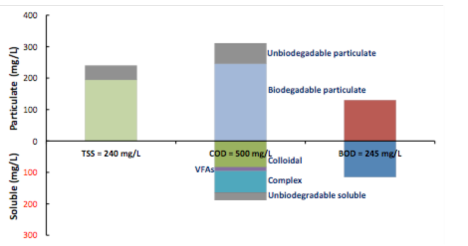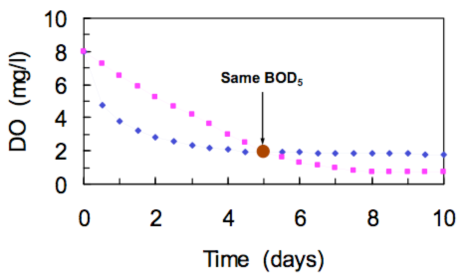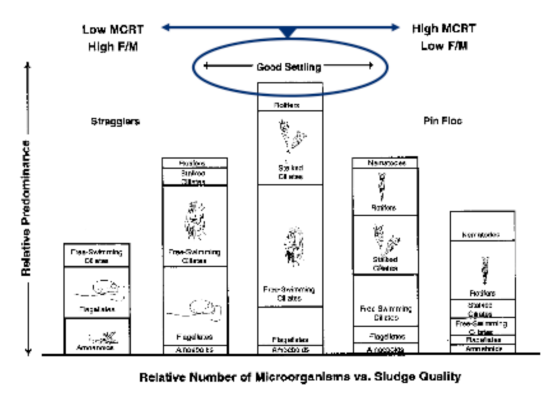Blog
Needed Change
- February 26, 2014
- Posted by: Eric & Patti Wahlberg
- Category: From the Mind of Eric Wahlberg
I ask wastewater treatment plant operators all the time what they think their jobs are. Invariably I get the answer, “To meet effluent permit.” Even when I was starting out my career as a wastewater treatment plant operator-in-training in Silverthorne, Colorado,
in the late ‘70s, this response seemed lacking to me; there was much more, in my opinion, to being an operator than just making permit. Over the years, I have crafted the following description of what I think our objective as operators is:
To remove pollutants from the incoming water, while complying with all permit requirements−water, land and air−and convert them to safe disposable biosolids as sustainably and cost effectively as possible.
My experience is that most operators do not fully appreciate, or even acknowledge, the “… as sustainably and cost effectively as possible” part of this mission statement. Combining the overwhelming complexity inherent in this rather simple statement with the technological sophistication being designed into most treatment plants today, I think it is time for an orchestrated, deliberate shift in the way activated sludge wastewater treatment plants are operated today and, therefore, in the way we train and certify activated sludge wastewater treatment plant operators.
I started at the Silverthorne/Dillon Joint Sewer Authority’s Blue River Wastewater Treatment Plant in April 1978. The following January, I was delighted to be offered the opportunity to attend the University of Colorado’s Rocky Mountain Water and Wastewater Plant Operators School in Boulder (http://waterwastewater.org/plant-operations/fundamentals-school). Learning the fundamentals of wastewater treatment from the likes of Lynn Marshall, Ron Schulyer, and others was so gigantically motivating and rewarding. With absolute conviction, I returned to my job armed with the process control test protocols developed and espoused by EPA’s Al West. Although simple, these protocols took a lot of the guesswork out of activated sludge process control and well served many, many operators across the country. As a newly certified operator, I remember giving tours of the Blue River Treatment Plant, proudly standing at the aeration basin, knowledgeably explaining, “Here in the aeration basin, we have to maintain the right mass of microorganisms for the amount of food, or organics, entering the plant.”
That was 35 years ago and not very much has changed in the way we train and certify operators across the county! Moreover, my proud explanation of aeration basin control was completely wrong, although it is what all operators are taught to this day. For these reasons, I am advocating we revamp the way we teach wastewater treatment to operators so they have a chance of accomplishing the objective stated above. Wastewater treatment is a proud and noble profession, so let’s get it right.
There is no way I can describe here, or even outline, all the changes we need to make in operator training, so I will concentrate this discussion on two fundamental changes upon which much of the revamping needs to be based: (1) there is more that is similar than different from wastewater treatment plant to wastewater treatment plant, and (2) the M is a response to the F in F:M and is controlled by the microbes, not by engineers and operators.
More Similar Than Different
Operators have always been told every treatment plant is unique because every wastewater is unique. Certainly an activated sludge plant treating the discharge from a pulp and paper mill in northern Saskatchewan is uniquely different than an activated sludge plant serving a ski resort in the Rocky Mountains because the characteristics of the wastewaters treated are very different. And maybe before the discharge of incompatible wastes to municipal wastewater systems was as highly regulated—for very good reason—as it is today, then varying influent wastewater characteristics may have set different plants apart from each other. But that was then and this is now.
Much research has been done in recent years in characterizing the different components in wastewater, driven by the COD-based wastewater treatment models in wide use by the profession (e.g., BioWin, GPS-X and others). Figure 1 shows the relationship between TSS, BOD and COD for a typical municipal influent.

Figure 1. The relationship between TSS, BOD and COD for a typical municipal raw wastewater showing COD fractions.
Wastewater treatment is getting very sophisticated. As the sophistication of the treatment processes increases, so must our understanding of the wastewater we treat. In the “good old days,” all we really cared about was influent BOD and TSS. Here, let’s just look at BOD. When I say “BOD,” like most in our profession, I am referring to the five-day BOD, or BOD5. Let’s suppose we set up BOD bottles for two wastewaters using the same sample volume for each; each day we take the bottles out of the incubator and measure the dissolved oxygen (DO) concentration. The DO concentration data for the two wastewater samples is shown in Figure 2 for ten days. Looking at the two curves, it is clear that the rate at which the organics in the two samples were oxidized was very different, yet on Day 5 the two samples had the same DO concentration and, therefore, by calculation, would have the same BOD5. The problem with the BOD5, as evidenced by this example, is that it doesn’t tell us anything about the rate at which the organics are oxidized and converted by the microbes in the BOD test. For example, in a conventional activated sludge plant, a design engineer would have to provide very different aeration system designs for these two wastewaters.

Figure 2. Comparison of oxygen consumption curves for two wastewaters showing same BOD5 but very different rates of organic degradation.
There are other problems with the BOD test besides the one just discussed. COD is a much more precise measurement, and the COD directly measures the oxygen equivalents in a sample, and can be used in performing mass balances.
Currently, the wastewater treatment profession separates COD into the different categories shown in Figure 1: (1) particulate (above the horizontal line) and soluble (below the line) (2) biodegradable particulate, (3) unbiodegradable particulate, (4) colloidal (which is particulate but measured as soluble in a filtered sample), (5) soluble that is volatile fatty acids (VFAs), (6) soluble that is complex, and (7) unbiodegradable soluble. The primary reason for separating COD into these categories is because we know that these different COD fractions biodegrade—if they biodegrade at all—at different rates.The more accurately we know the rate of biodegradation for all the biodegradable constituents in wastewater, the more accurately we can model—and design—aeration requirements, sludge production, and nutrient requirements to name a few.
The climax of this entire discussion is that, generally speaking, while the concentration of COD varies, the relative proportions of the COD fractions are very consistent from one municipal wastewater to the next. While, certainly, different wastewater treatment plants have different unit processes and even different configurations of the same unit processes, the characteristics of the wastewaters we treat are more similar than they are different, and we all share the same objective (see above).
The problem with telling operators, as we have for far too long, that every wastewater treatment plant is unique, is that this gives them license to do whatever they want to do. As a result, many operators use “uniqueness” to make such ignorant statements as: “My sludge is both young and old,” “I run my plant based on smell and observation,” “We tried it once and it didn’t work,” “It costs too much,” “We’re doing all right without it,” “We’re not ready for that here,” “We’ve never done it that way,” “SRT control can’t be used here,” “That’s not our responsibility,” or simply, “It won’t work here.”
As a profession, we must focus on the similarities between municipal wastewater treatment plants rather than their differences. Doing so allows us to excel together.
M Responds to F in F:M
I am not quite sure when or why it got started, but somewhere along the line, activated sludge operators either started being told or decided themselves that the amount of biomass in the system—either mass or concentration, either MLSS or MLVSS—was in their control and, in fact, that it was the most important parameter for them to control. For example, from Operation of Wastewater Treatment Plants, Volume II, 6th Edition, page 58: “If you know the amount of waste (food) entering the aerator, you can provide sufficient organisms in the aerator to treat (eat) the incoming waste.”
My first question is: When do we ever “know the amount of waste (food) entering the aerator”? BOD results, typically done on flow-weighted composite samples, are not available, at a minimum, for five days after the samples are collected for the day before, so, really, six days minimum. COD results, also typically done on flow-weighted composite samples collected yesterday, are available in three to four hours, but they are for yesterday. Even if a grab sample is collected and analyzed for COD, by the time the result is available to the operator, the concentration of organics entering the aeration basin likely would be totally different than it was three to four hours ago.
My second question is: Who knows better than the microorganisms themselves what the organic concentration is at any given instant? For too long we have asserted, incorrectly, that engineers and operators know better how much organic matter is entering an aeration basin. The numbers we use to make this assertion are based on grab samples taken several hours or several days ago, or composite samples taken over a 24-hour period one or more days ago. Who are we fooling? Ourselves, because it certainly isn’t the microbes.
Consider this suggestion, also taken from Operation of Wastewater Treatment Plants, page 127:
“There are times when taking process units (tanks) out of service could be considered a process change. If multiple primary clarifiers are used, one or more could be taken out of service to increase the F:M of the activated sludge.”
The reasoning behind this suggestion is that taking primary clarifier capacity off line will result in a decrease in performance of the remaining on-line units, which has merit. The decrease in the performance of primary clarification will result in more BOD being discharged to the aeration basins. Additional reasoning behind this suggestion is that the operator will maintain the same mass of microorganisms in the aeration basins despite the increase in organic load; this is the only way, as suggested, that an “increase” in the F:M would be possible. But what do you think the microorganisms want to do when faced with more “food?” They will grow more microorganisms! This is what microbes do! We know, too, what happens to the mass of microorganisms when the mass of organics to the aeration basins goes down: it decreases. We know this because this is what happens in aerobic digesters, which are nothing more than aeration basins receiving no “food.” To add insult to injury, engineers and operators think it is their job to control the number of microorganisms in an activated sludge system based on a measurement of organics that is at the most irrelevant but most certainly untimely.
The microbial response to an increase or decrease in the mass of organics influent to an activated sludge system can be further explained with the equation used by engineers to design activated sludge systems, which is given in Figure 3. Without going into a long discussion of what all the variables are in this equation, all operators should know that the mass of microorganisms (MLSS∙Va on the left-hand side of the equation), essentially the M in F:M, responds to all of the variables on the right-hand side of the equation. The mass of microorganisms in an activated sludge system is a response variable not a control variable. All activated sludge treatment plant operators should know this, and stop listening to anybody telling you otherwise.

Figure 3. Activated sludge design equation (MLSS = mixed liquor suspended solids, Va = on-line aeration tank volume, SRT = solids residence time, Q = influent flow, ISSINF = inorganic suspended solids concentration in influent to activated sludge system, Yg = growth yield, BODINF = activated sludge influent BOD concentration, BODEFF = activated sludge effluent soluble BOD concentration, and b = decay coefficient).
This equation is profound in what it is telling us: for a given SRT and inorganic and organic loads (Q∙ISSINF and Q∙BODINF, respectively), a fixed mass of solids in the system (including the secondary clarifier(s), but that’s a conversation for another day) will result (there’s a temperature dependence, too, but that also can wait for another day). This is so important it is worth repeating: for a given SRT and inorganic and organic loads, a fixed mass of solids in the system will result.
The SRT (or its mathematically similar mean cell residence time, MCRT) in the equation in Figure 3 is the most important control variable—and the only one that matters since it controls all others—in the activated sludge process. While it is typically described as the average time a bacterial cell resides in the activated sludge system before being either intentionally removed via the waste activated sludge flow or unintentionally removed in the effluent flow, it is much more meaningful to define it as the reciprocal of the growth rate of the microorganisms in the system (okay, not exactly, but very close). The reason this is more meaningful is because the growth rate controls two all-important aspects of activated sludge: (1) whether or not nitrification will occur, and (2) sludge quality (that is, how the sludge flocculates, settles and compacts).
Operators have long known that SRT (similar to MCRT) controls sludge quality because they have been endlessly schooled in the graphic given in Figure 4. Unfortunately when using this graphic, way too much emphasis has been given to counting rotifers and stalked ciliates than attention given to the fact that Good Settling (i.e., good sludge quality) occurs at a measurable and controllable SRT (since no numbers are given in the graphic, it is unknown what that optimum SRT is). Again, the graphic shows that the SRT controls activated sludge sludge quality. This is because it controls the growth rate of the microorganisms in the system.
 Figure 4. Graphic showing relationship between SRT (MCRT) and sludge quality (“Good Settling”), and, supposedly, the relative numbers of “indicator organisms.”
Figure 4. Graphic showing relationship between SRT (MCRT) and sludge quality (“Good Settling”), and, supposedly, the relative numbers of “indicator organisms.”
Control of the activated sludge process is very simple: identify the SRT that gives the sludge quality desired and meets permit with respect to ammonia and maintain that SRT. As the microorganisms respond to changes in temperature, inorganic and organic concentrations, and flow, the MLSS concentration and mass (also the MLVSS concentration and mass) will trend up and down accordingly. The key is to maintain good sludge quality, not a supposedly “appropriate” sludge mass or concentration.

Great stuff Eric! I agree, trying to control a plant with a response variable is not the best way of doing things.
Ryan,
Thanks. I am on a quest to get the industry away from using MLSS concentration and mass as a control parameter. Everybody that switches to SRT/MCRT control is amazed at how it stabilizes sludge and effluent quality! Thanks, again.
Eric
Very interesting work Mr. Wahlberg. I’m a wastewater treatment plant operator in Belgium, Europe. This post of you gives me an entire new point of view on the operation of the plant. I certainly am going to discuss this interesting operation method with my superiors. As for myself, I’am convinced of the things You describe here. Thank’s for sharing this method !
Frederik Wynants